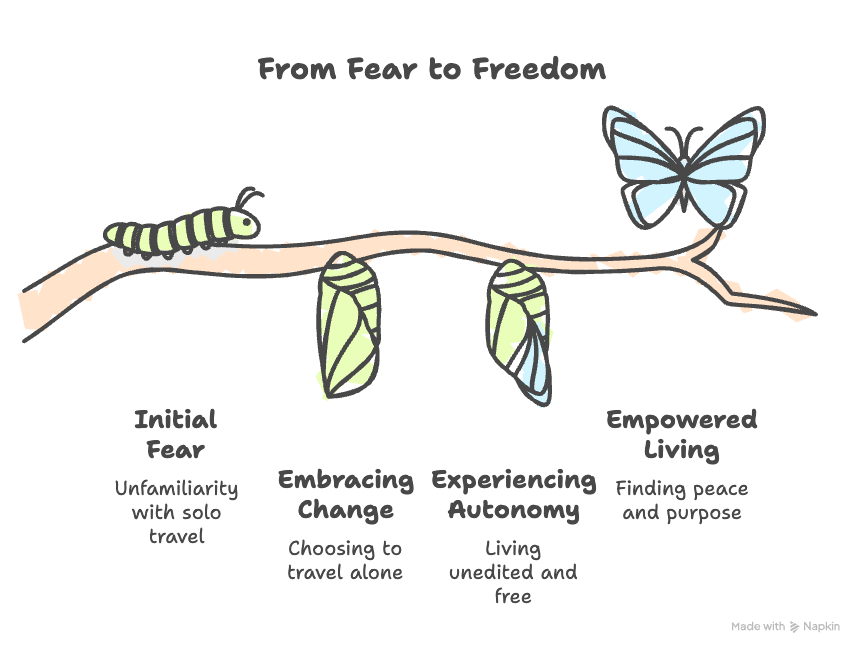The Art of Living Alone After 55 - Freedom, Joy, and Power
Celebrates the art of living alone after 55 — whether by choice or circumstance.
Reframe solo living as a time of vitality, creativity, and independence.
Summary: The Art of Living Alone After 55: Freedom, Joy, and Personal Power
This empowering blog celebrates the beauty of living alone after 55 — whether by choice or circumstance. Through affirming stories, research, and gentle lifestyle rituals, it reframes solo living as a time of vitality, creativity, and independence.
A Preamble - The Art of Living Alone
How Embracing Independence Can Be the Most Beautiful Chapter Yet
“It’s just me — and that’s more than enough.”
When Elaine, 67, told me she was heading to Prince Edward Island for a solo getaway, she grinned like a teenager with a secret. “I’ve never travelled alone,” she confessed. “But I’m finally ready to live the way I’ve always dreamed — unedited, unaccompanied, and unapologetically free.”
Her story isn’t rare, but it’s still quietly revolutionary. For many women over 55, solo living (by choice, by chance, or by circumstance) often begins with fear… and then unfolds into power, peace, and purpose. Let’s explore this.
Embracing Independence Can Be the Most Beautiful Chapter Yet. Practice solo living.
“But I’m finally ready to live the way I’ve always dreamed — unedited, unaccompanied, and unapologetically free.”
Why Solo Living After 55 Is So Emotionally Resonant
The later chapters of life bring enormous transitions: retirement, empty nests, divorce, widowhood, or simply a long-awaited return to self. And while society often whispers that being alone is something to fix or fill — the truth is, it can be something to celebrate.
A 2022 report from the American Psychological Association found that older adults who embraced autonomy and solo living experienced higher levels of self-esteem, creativity, and personal growth.
In other words, being on your own doesn’t mean being less.
It often means becoming more.
It is one example of how to live alone happily by reconnecting with your sense of purpose.
And while society often whispers that being alone is something to fix or fill — the truth is, practicing solo living can be something to celebrate.
A 2022 report from the American Psychological Association found that older adults who embraced autonomy and solo living experienced higher levels of self-esteem, creativity, and personal growth. [¹]
Solo Does Not Mean Lonely
Let’s debunk the myth: solitude ≠ loneliness. Learning how to stay positive alone can change everything.
In fact, according to The Journal of Women & Aging, women over 55 who live alone and actively nurture their independence often report lower rates of depression than those in unsatisfying partnerships or caregiving roles.
Why? Because solo living creates space for things many women have long sacrificed:
Creative expression
Personal rituals
Rest without interruption
Spontaneity
The ability to say yes or no — without negotiation
These are just a few of the many benefits of solo living.
Let’s debunk the myth: solitude ≠ loneliness.
In fact, according to The Journal of Women & Aging, women over 55 who live alone and actively nurture their independence often report lower rates of depression than those in unsatisfying partnerships or caregiving roles. [²]
Story Time: Mae’s Midlife Reclamation
Mae, 61, had been married for over 30 years when she found herself alone for the first time. She feared quiet evenings and weekends. But instead of collapsing into the void, she decided to fill it intentionally.
She created a solo living ritual:
Friday dinners with candles and her favourite jazz album
Sunday walks in the woods followed by reflection journaling
A “yes list” where she tried one new thing a month — painting, kayaking, solo day trips
Mae says: “Solo living gave me back my voice. I don’t feel lonely — I feel alive.”
Her story is an excellent example of embracing solitude.
Mae, 61, had been married for over 30 years when she found herself alone for the first time. She feared quiet evenings and weekends.
But instead of collapsing into the void, she decided to fill it intentionally.
7 Ways to Embrace the Art of Solo Living After 55
1️⃣ Reclaim Your Space, Your Way
Whether it’s a cottage, condo, or cozy apartment, your home can become a sacred expression of you.
Rearrange furniture
Paint a wall your favourite colour
Create a solo morning or bedtime ritual corner
2️⃣ Solo Travel (Even Just Around the Corner)
You don’t need a passport to be bold.
Take a day trip to a nearby beach or botanical garden
Dine out with a journal as your dinner date
Sign up for a guided tour or museum visit solo
Travel + Leisure notes that women over 60 are the fastest-growing segment of solo travellers — and report increased confidence, curiosity, and joy.
One of the best tips for a solo life: start small and explore often.
3️⃣ Curate Connection (Without Compromise)
Solo living doesn’t mean isolating.
Choose your circle with intention:
Weekly coffee dates
Online creative communities
Hosting small gatherings that match your energy
Solo living means socializing on your terms — with time to recharge afterward.
4️⃣ Start a "Solo Joy Journal."
Each evening, jot down:
One thing you did just for you
One quiet moment you savoured
One thing you’re proud of
This simple ritual can rewire your mindset from “alone” to “abundant.”
🔗 Explore more reflective prompts in the Self-Discovery Workbook.
5️⃣ Indulge Without Justification
Want to take a nap at noon? Watch an entire K-drama? Rearrange your bookshelves by colour?
Do it.
Solo living removes the invisible scoreboard. You get to choose what’s “worthwhile.”
6️⃣ Find Freedom in Structure
Ironically, a little routine can make solo living feel anchored rather than aimless.
Try:
Morning walks
Weekly creative blocks
Regular check-ins with your goals or dreams
🔗 Reignite your vision with the Joy Blueprint Workbook.
7️⃣ Celebrate This Chapter — Boldly
Mark this phase of your life with intention:
Host a “solo-versary”
Write a letter to your younger self
Create a solo-living vision board
This isn’t a waiting room. It’s a freedom suite — and you hold the key.
Travel + Leisure notes that women over 60 are the fastest-growing segment of solo travellers — and report increased confidence, curiosity, and joy. [³]
You get to choose what’s “worthwhile.”
Celebrate This Chapter — Boldly
Solo Living Is Not the End — It’s a New Beginning
Whether you choose solo living or it chooses you, this chapter is yours to shape.
Freedom, joy, and personal power aren’t loud or flashy — they are often found in the quiet rituals, the spontaneous road trips, the unshared bed, the shelf full of books you love, and the ability to laugh at your own jokes over dinner.
You are not missing something.
You are becoming whole — on your terms.
Whether you chose solo living or it chose you, this chapter is yours to shape.
You are not missing something.
You are becoming whole — on your terms.
📝 Ready to Embrace Your Next Chapter?
Download your free Self-Discovery Workbook — 3 fun exercises to help you explore your values, passions, and solo-living strengths.
👉 Grab It Here
🌿 Go Deeper with The Joy Blueprint Workbook
Design your best life — filled with confidence, delight, and freedom.
👉 Explore Now
Bonus Section: Common Challenges of Living Alone (and How to Navigate Them)
While solo living offers freedom, it also comes with its own learning curve. Let’s name them:
Occasional loneliness
Home maintenance overwhelm
Lack of daily conversation
The good news? Each of these can be addressed with support, routines, and mindset shifts. If you’re working on overcoming loneliness, seek regular, nourishing contact with others — even a friendly chat with a neighbour can lift your spirits.
And remember: staying positive alone is a practice, not a personality trait. With intention and self-kindness, it becomes easier each day.
[¹] American Psychological Association, 2022; [²] Journal of Women & Aging, 2023; [³] Travel + Leisure, 2023.
NOTE: To check out my newest article on Medium, please click this link: Flirting with Life Again: Saying Yes to Joy, Play, and Possibility
FAQ
Q1. Who is this article for?
A1. For women aged 55 + who are living alone (by choice or by circumstance) and are ready to embrace this season of life with freedom, personal power, and joyful intention.
Q2. What do you mean by “living alone”?
A2. Solo living means you’re the sole occupant of your home, or you’re exercising independence in your daily life. This article explores how that can be a rich, creative chapter—not just a transition or a waiting room for something else.
Q3. What are the main themes?
A3. Some of the key themes include:
Shifting mindset from “alone = lonely” to “alone = opportunity”
Establishing routines and rituals that support your wellness, meaning, and connection
Cultivating your home as a sanctuary for you
Building community and connection on your own terms
Embracing the freedom and self-discovery that this chapter brings
Q4. Will it help me if I’m single but not alone (e.g., live with a partner)?
A4. Yes—while the primary focus is on women who live by themselves, many of the mindset shifts and practices apply equally to any woman over 55 who wants more intentional independence, self-reliance, and joy in her life.
Q5. What practical tips will I find in the article?
A5. You’ll find guidance like:
How to structure your home and schedule to support the life you want
How to handle common fears (e.g., loneliness, safety, isolation) with self-compassion and strategy
Ways to stay connected (without always depending on others)
Ways to lean into your unique interests, rhythms and values—no longer shaped by “we” but by what you want
Q6. How can I get started?
A6. Start small: choose one routine or ritual that honours your living-alone status (for example, a solo Sunday brunch you actually enjoy, a “what I want” home project, or joining a group that interests you). Build from there.
Q7. Does the article replace professional advice?
A7. No. It offers inspiration, mindset shifts and practical suggestions tailored for women 55+. If you’re experiencing serious loneliness, depression, safety concerns, or major life transitions tied to “living alone,” you may wish to consult a qualified therapist, life coach or other professional.
👉 I thoughtfully use AI tools to polish my writing, but every story comes from my lived experience.









































